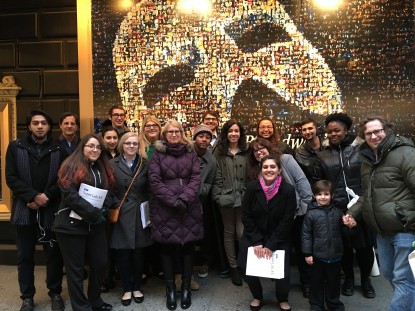Previous EPA Meetings
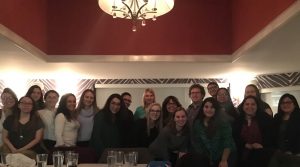 EPA Meeting 2017 – Boston
EPA Meeting 2017 – Boston
Fourteen SPU students and 4 faculty members from the Psychology department attended the annual meeting of the Eastern Psychological Association, March 16-19th in Boston, MA. We presented 10 student-faculty research collaborations at the conference.
 Adaptation to Motion Sickness in an Optokinetic Drum
Adaptation to Motion Sickness in an Optokinetic Drum
Andrea Bubka (Saint Peter’s University), Frederick Bonato (Montclair State University), Caitllin Osmanski (Saint Peter’s University)
In a two-day experiment, participants sat in a stationary (control Group) optokinetic drum with a checkerboard lining or a spinning one (experimental group) for five minutes on day 1. On day 2, both groups sat inside the spinning drum for 10 minutes. The experimental group displayed significantly fewer symptoms of motion sickness on day 2 than the control group. The findings suggest that adaptation is possible in as little as one trial.
 Attributional Biases in the Perception of Cheaters
Attributional Biases in the Perception of Cheaters
Joshua Feinberg, Rebecca Sanchez, Maranda Berry (Saint Peter’s University)
The present study examined participants’ perceptions of academic cheating. A factorial design analyzed participants’ judgements of one’s self compared to a classmate (actor observer bias) across three different s scenarios that also varied on covariation factors (consensus, consistency, and distinctiveness) behavior and internal attributions in judging a classmate. In addition, covariation factors were more likely to influence judgments of the classmate rather than self-judgments.
 Just Based off Her Appearance
Just Based off Her Appearance
Isabel Murphy, Joshua Feinberg (Saint Peter’s University)
This experiment analyzes if a woman’s hairstyle creates judgments based on gender stereotypes. The study presented participants images of an African American or Caucasian woman with varying hairstyles. The target images had either long or short hair that is curly or straight, or hair completely pulled back. The results found that even though both models were rated equally attractive, participants rated the images with short hair as less feminine than the image with long straight hair.
 Lack of Awareness of Sexual Assault in the Military
Lack of Awareness of Sexual Assault in the Military
Anyelina Alvarado, Joshua Feinberg (Saint Peter’s University)
This study examines the lack of awareness of sexual assault in the military. The purpose of this study is to find whether the lack of awareness of sexual assault in the military is due to the stereotypes society holds for military males. Participants rated males in the military as more masculine than males or females. Furthermore, the more traditionally masculine a victim is, the less likely participants believe assault takes place.
 Manipulating Conceptual and Perceptual Disfluency in a Classroom Setting
Manipulating Conceptual and Perceptual Disfluency in a Classroom Setting
Brenda Chavez, Maryellen Hamilton (Saint Peter’s University)
Dis fluency effects refer to the increased recollection of items that are more difficult to encode. Typically these manipulations involve perceptual disfluency. The purpose of this experiment was to compare disfluency effects for perceptual disfluency (font changes) and conceptual disfluency (generating items) for typical classroom materials. The results suggest that disfluency may help with learning. Implications of these findings will be discussed.
 Fixed-paced and Self-paced Studying with Single and Multi-trial Learning
Fixed-paced and Self-paced Studying with Single and Multi-trial Learning
Kimberly Mena, Maryellen Hamilton (Saint Peter’s University)
The experiment was done to examine the effects of type of studying; fixed-paced or self-paced, and the amount of study trials, single or multi-trial, on word recall. Participants attempted to learn Dutch translations in one of four study conditions. It was found that neither the different types of studying, nor the different amount of study trials, had a significant effect on the amount of words recalled. Implications of these findings will be discussed.
 Does Dynamic Visual Noise Interfere with Concreteness Effects in Short-term Memory?
Does Dynamic Visual Noise Interfere with Concreteness Effects in Short-term Memory?
Emilie Geesey, Isabel Murphy, Maryellen Hamilton (Saint Peter’s University)
This experiment examined the effect of dynamic visual noise (DVN) had on the concreteness effect within short-term memory. Participants were given either a blank white screen or a DVN while listening to five-word sets of abstract or concrete words. An interaction was found such that a concreteness effect was found in the blank condition but not in the DVN condition. This suggests that concreteness effects are dependent on visual imagery even in STM.
 Does the Type of Response Impact the Spatial Stroop Effect?
Does the Type of Response Impact the Spatial Stroop Effect?
Lori Reeves, Maryellen Hamilton (Saint Peter’s University)
The spatial Stroop effect holds that interference occurs between a word’s location and word meaning. The current experiment was developed to test the spatial Stroop effect where participants responded either manually or verbally. A significant interaction was found between congruency of the word with location and the type of response the participant provided. Participants took the longest to respond in the incongruent manual condition. Implications of these findings will be discussed.
 Duration of False Memories Following a Mindfulness Meditation
Duration of False Memories Following a Mindfulness Meditation
Maryellen Hamilton (Saint Peter’s University), Melissa Dolese (Colorado State University-Pueblo), Melanie Aleman, Emilie Geesey (Saint Peer’s University)
Participants took part in either a mind wandering task or a mindfulness meditation. In addition, they participated in an immediate and a delayed DRM recall task, a significant interaction was found for the number of false memories between the type of task and the timing of recall. More false memories were found for the mindfulness meditation group with a delay. Implications of these findings will be
discussed.
 Does Attitude Moralilation Lead to Greater Attitude Accessibility?
Does Attitude Moralilation Lead to Greater Attitude Accessibility?
Cynthia Soto, Daniel Wisneski (Saint Peter’s University)
The current study tested whether moralizing a political attitude leads to that attitude being more accessible from memory. Across four different political issues (abortion, same-sex marriage, capital punishment, gun control), we found little support for this hypothesis. Contrary to several theories in the fields of both moral psychology and attitude strength, we found little evidence that attitude moralization leads to heightened accessibility.
EPA Meeting 2016 – New York City
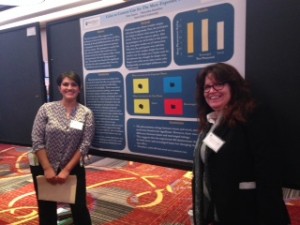 Color as Context Clue for the Mere Exposure Effect
Color as Context Clue for the Mere Exposure Effect
Elise Soares (Saint Peter’s University), Maryellen Hamilton (Saint Peter’s University)
The mere exposure effect suggests that preference is shown for familiar items. De Zilva, Mitchell, & Newell (2013) found that this effect is dependent on the match between exposure and test context. We attempted to expand this idea and see whether color could serve as a context cue for the mere exposure effect. Items were presented with white or color backgrounds as cues. Mere exposure effects were found for intact items regardless of color backgrounds.
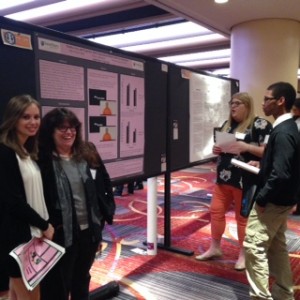 Truths, Lies and Expertise: How Expectations Effect Truth-Lies Judgements
Truths, Lies and Expertise: How Expectations Effect Truth-Lies Judgements
Marcella Devenuta, Alyssa M. Lindenbaum, Maryellen Hamilton (Saint Peter’s University)
The current study examined the effect of base rate manipulations and perceived expertise on truth-lie judgments. Participants made judgments on whether a person in a video was telling the truth. Expectations were manipulated by providing base rate information on the level of honesty. In addition, half of the people in the videos were labeled as experts. Truth judgments were highest when participants expected truthful testimony however non-experts were perceived as more truthful than experts.
Can the Relationship Between a Color and an Emotion Effect Word Recall? 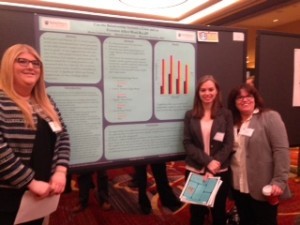
Alyssa M. Lindenbaum, Marcella Devenuta, Maryellen Hamilton (Saint Peter’s University)
Kuhbander and Pekrum (2013) found negative words were remembered best when presented in red, while positive words were remembered best in green. It was suggested that this was due to the relationship between those colors and emotion (red-negative; green-positive). We directly tested this by using positive words associated with the color red. We predicted these positive words should be remembered best in red. A significant effect was found, implications of these findings will be discussed.
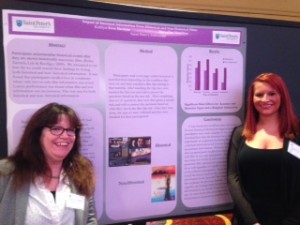 Impact of Incorrect Information from Historical and Non-Historical Films
Impact of Incorrect Information from Historical and Non-Historical Films
Kaitlyn Rose Herman, Maryellen Hamilton (Saint Peter’s University)
Participants misremember historical events after they are shown historically inaccurate films (Butler, Zaromb, Lyle & Roediger, 2009). We attempted to see how far we could extend these findings by testing both historical and non-historical information. It was found that participants recalled best in conditions where only test or only film information was tested. Lowest performance was found when film and test information was inconsistent. This was true for both historical and non-historical information
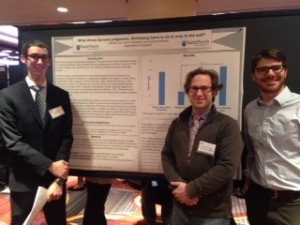 What Drives Fairness Judgements: Minimizing Harm to All or Only the Self?
What Drives Fairness Judgements: Minimizing Harm to All or Only the Self?
Michael Joll, Daniel Wisneski, Joshua Feinberg (Saint Peter’s University)
Building off both equity theories and theories of retributive justice, the current study tested competing hypotheses about what drives people fairness judgments. Specifically, we tested whether people’s fairness judgments are driven more by the number of people who are harmed or simply by whether they are personally harmed. The results showed that people’s fairness judgments depended primarily on whether they were personally harmed rather than on concerns about the number of people who were mistreated.
Are Conservative Attitudes More “Intuitive” Than Liberal Attitudes?
Jessica Carino, Daniel Wisneski (Saint Peter’s University)
This study tested the hypothesis that intuition leads people to report more conservative attitude positions, whereas deliberative reflective thinking leads people to report more liberal attitude positions. To test this, we experimentally induced intuitive or deliberative thinking and measured participants’ attitudes on a variety of political issues. Consistent with our hypothesis, intuitive processing lead to more conservative attitude stances and deliberation lead to more liberal stances.
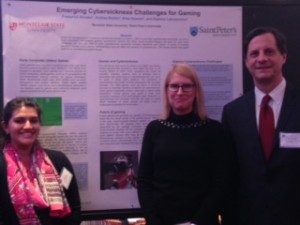 Emerging Cybersickness Challenges for Gaming
Emerging Cybersickness Challenges for Gaming
Frederick Bonato (Montclair State University), Andrea Bubka, Elise Soares (Saint Peter’s University), Daphne Labropoulos (Montclair State University)
Since the development of 1st person perspective games (e.g. Doom, 1993) increasingly sophisticated technology has led to more immersive and realistic gaming experiences. Future games that utilize head-mounted displays will allow for even more immersion but this may lead to more cybersickness symptoms including headache and nausea. A review of existing literature reveals some display characteristics that can affect the severity of cybersickness. This review should help guide both future research and game design.
EPA Meeting 2015 – Philadelphia
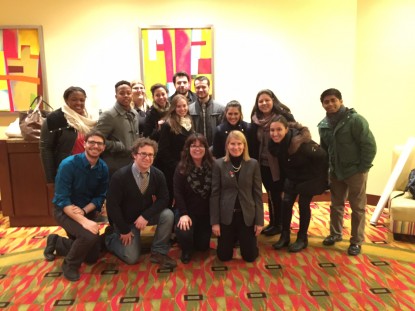
The annual meeting of the Eastern Psychological Association in Philadelphia PA on March 5-7. Four faculty members and 11 students attended. There were more than 10 student/faculty collaborative research projects presented.
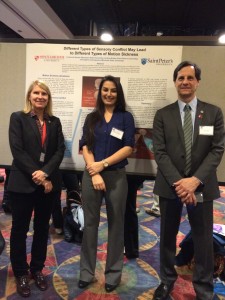 Visual Pathway Influences on Vection and Motion Sickness
Visual Pathway Influences on Vection and Motion Sickness
Andrea Bubka (Saint Peter’s University), Frederick Bonato, Daphne Labropoulos (Montclair State University)
Both vection and vection induced motion sickness may be dependent on different neurological pathways. Evidence that the periphery and magnocellular pathway play more of a role can be gathered from experiments showing that both chromatic color and lack of visual acuity (dependent more on the parvocellular pathway) exacerbate motion sickness symptoms. Color and visual blurring may lend more influence to the magnocellular visual pathway by weakening the role played by the parvocellular pathway.
Traditional Versus Cyber Bullying: The Role of Gender in Perpetration and Victimhood
Joshua Feinberg (Saint Peter’s University), Ronalice Politico (Saint Peter’s University)
Participants were presented with a vignette that varied on the type of bullying (in person versus cyber) and the genders of the perpetrator/victim pair. Participant judgments across conditions were analyzed. The results indicated that participants viewed cyber bullying as worse on several key variables and no different that “traditional” bullying on other key measures. Furthermore, several significant interactions indicated that female on male cyber bullying was viewed more harshly.

Divided Attention at Test Affects Subsequent Recall Differently Dependent on Time Intervals
Maryellen Hamilton (Saint Peter’s University)
Dudukovic, DuBrow & Wagner (2009) found dividing attention at test impaired performance on subsequent recognition. The current work found this effect was eliminated when using free recall tasks where there was no re-exposure to studied items that were not remembered. However, a significant benefit for the divided attention group was found when looking only at new items recalled on Test 2. Interestingly, this effect appears dependent on the time interval between Test 1 and 2.
Can Temperature Affect Taste Preference? 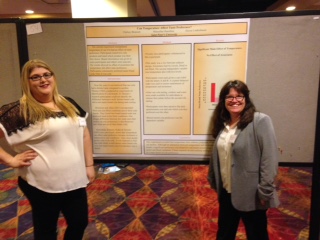
Chelsey Brunson, Maryellen Hamilton, Alyssa Lindenbaum (Saint Peter’s University)
Most research on cola taste preference serve their soda warm. The current experiment manipulated temperature to see if it had an effect on taste preference. Participants tested two cola products and rated which product was their first choice. Brand information was given to some participants and others were unaware. The results showed no effect of awareness but temperature did affect taste preference. Participants consistently preferred name brand soda when it was cold.
 Visual Short Term Memory Advantage as a Result of Familiarity
Visual Short Term Memory Advantage as a Result of Familiarity
Peter Telidecki, Maryellen Hamilton (Saint Peter’s University)
An advantage for visual short term memory as a function of familiarity was tested. Participants were tasked with a match sample probe recognition test with an articulatory interference task. The recognition test presented subjects with familiar and unfamiliar item sets and a test picture that the subject would define as matching the set or not matching the set. The results support the concept that familiarity improves visual short term memory.
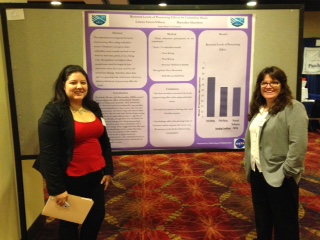 Reversed Levels of Processing Effect for Unfamiliar Music
Reversed Levels of Processing Effect for Unfamiliar Music
Lorena Yerovi, Maryellen Hamilton (Saint Peter’s University)
The experiment investigated the levels of processing effect using unfamiliar music. Volunteers were given thirty unfamiliar music sounds and had to rate them by their time, pitch, or on a liking scale. Recognition was highest when sounds were rated for length of time and lowest when they were rated for self-preference (liking). Therefore, these data add to a growing body of literature which has failed to find levels of processing effects for music.
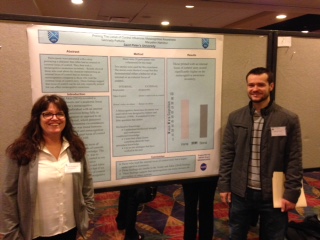 Priming the Locus of Control Influences Metacognitive Awareness
Priming the Locus of Control Influences Metacognitive Awareness
Gennady Fortuna (Saint Peter’s University), Maryellen Hamilton (Saint Peter’s University)
Participants were presented with a story portraying a character that either had an internal or external locus of control. They then took a metacognitive awareness inventory. Results showed those who read about the character representing an internal locus of control had an increase in metacognition compared to those who read the external locus of control story. These findings suggest that locus of control can not only be implicitly primed but can affect metacognitive awareness.
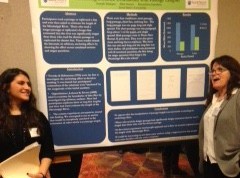 Anchoring Distance Estimations With Passage Lengths
Anchoring Distance Estimations With Passage Lengths
Joseph Stampar, Elise Soares (Saint Peter’s University) Maryellen Hamilton, Saint Peter’s University
This study examined arbitrary anchoring effects. Participants read either long or short passages. They were then asked to estimate the length of the Mississippi River. Those who read the longer passage estimated that the river was significantly longer than those who read the shorter passage. These results extend the literature on arbitrary anchoring effects by showing the effect across unrelated anchors and target questions. Implications of these findings will be discussed.
 Do Bilinguals Always Have Superior Executive Functioning?
Do Bilinguals Always Have Superior Executive Functioning?
Nelcida Llissett Garcia, Maryellen Hamilton (Saint Peter’s University)
The management of two active language systems has led to the assumption that bilinguals have a superior executive function system. However, research has also shown that bilinguals do not perform as well as monolinguals on some verbal tasks. The current experiment tested monolinguals and bilinguals on a lexical decision task as a measure of both executive functioning and verbal ability. No evident of superior executive functioning nor verbal deficit were found in this study.
EPA Meeting 2014 – Boston
Twelve Saint Peter’s University students (including 2 graduates), Drs. Maryellen Hamilton, Michael Greenstein, Joshua Feinberg, Andrea Bubka from the Psychology Department and Dr. Frederick Bonato from Montclair State University attended the Eastern Psychological Association (EPA) conference in Boston March 13-15, 2014. Ten posters/papers were presented, their abstracts listed below.
 Challenges for Adaptation to Motion Sickness
Challenges for Adaptation to Motion Sickness
Frederick Bonato (Montclair State University), Andrea Bubka, Shannon Daniels, Kayla Hanley (Saint Peter’s University)
It is well known that adaptation to conditions that cause motion sickness and its variants (e.g. space motion sickness, simulator sickness) occur, but finding ways to systematically ‘desensitize’ individuals to nauseogenic stimuli has been a challenge. Results obtained by our group and others suggest that sometimes adaptation can be rapid and both statistically and clinically significant. A main goal however is to transfer adaptation benefits from one environment (e.g. lab) to another (e.g. spacecraft, aircraft).
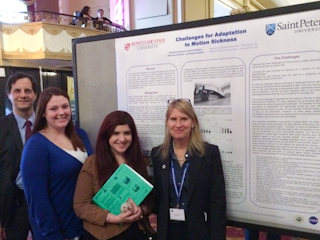 Cybersickness and Small Devices
Cybersickness and Small Devices
Valezka L. Cruz, Kayla R. Hanley (Saint Peter’s University), Alexandra Velazquez, Shannon Daniels (Saint Peter’s University), Andrea Bubka (Saint Peter’s University), Frederick Bonato (Montclair State University)
With the iOS 7 software design for iPhones and iPads, some users have reported cybersickness symptoms such as headache, eyestrain, dizziness, vertigo, and even nausea. It has been documented that simulators and 3D movies with large screens can produce such symptoms. Can cybersickness occur while using a device with a small screen? Results of an experiment conducted on these devices with and without motion suggest that cybersickness can be produced. Adaptation will be discussed.
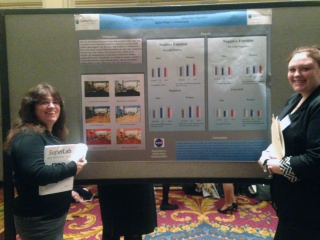 Gender Differences on Emotional Responses for Color and Saturation
Gender Differences on Emotional Responses for Color and Saturation
Kayla Rose Hanley, Maryellen Hamilton (Saint Peter’s University)
Gender differences have been found both in color preference and the emotional impact of color (Yildrim, 2007; 2011;). The current experiment attempted to further these findings by adding the variable of saturation. Participants were presented with pictures varying in color type and color saturation and they had to indicate how the picture made them feel. Gender differences were found on emotions for both saturation and color type. Implications of these findings will be discussed
Effects of Opinion Agreement on Perceived Source Expertise 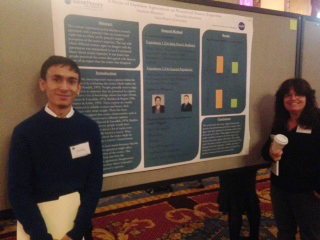
Sandesh Bhandari, Maryellen Hamilton (Saint Peter’s University)
The current experiment tested whether a source’s agreement with a person’s view on controversial topics has an effect on the person’s implicit perception of the source’s expertise. The rate with which different sources agree or disagree with the participants was manipulated to see if it produced biases about source expertise. It was found that people perceived the source that agreed with them as more of an expert than the source that disagreed.
Reliability and Validity of Three Constructs About Facebook Behavior 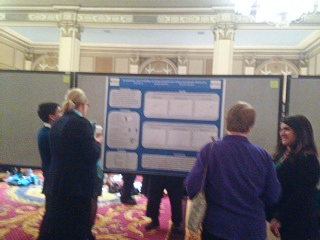
Elise Soares, Sandesh Bhandari, Maryellen Hamilton (Saint Peter’s University)
Greenwood (2013) created a test that classified Facebook (FB) behaviors into three constructs; FB-Posting, FB-Responding and FB-Lurking. The purpose of the current study was to expand this test by increasing the number of test items and to assess the reliability of the items and validity of the constructs. It was found that the new test had good inter-item reliability. However, the results question the validity of FB-Posting and FB-Responding as distinct constructs.
Repeated Shape Effects in Visual Short Term Memory Tasks Using Black & White Stimuli With Inherent Colors 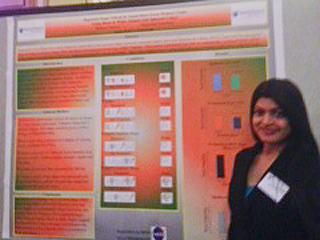
Mahum Hashmi, Maryellen Hamilton (Saint Peter’s University)
Repeated color effects have been found on visual short term memory tasks, however, repeated shape effects have not (Quinlan & Cohen, 2012). Last year we presented data showing a repeated shape effect on items with inherent colors (e.g., yellow banana). The current experiment was able to replicate this repeated shape effect using shapes with inherent colors (e.g., banana) presented in black and white. These data suggest items’ colors can influence retention without the color present.
The Effect of Anger on Acceptance of False Information; Michael Greenstein (Saint Peter’s University)
Anger promotes processes that allow people to respond quickly in dangerous situations. However, this quick responding leads people toward cognitive and metacognitive errors. We demonstrated this using two misinformation paradigms and found that angry participants were more susceptible to misinformation than were neutral participants. While making more errors, angry participants were also more confident in their memory. Two potential mechanisms for this were observed: impaired suppression and a reduced threshold for acceptance of misinformation.
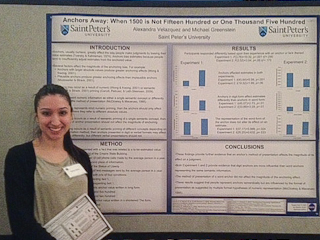 Anchors Away: When 1500 is Not Fifteen Hundred or One Thousand Five Hundred
Anchors Away: When 1500 is Not Fifteen Hundred or One Thousand Five Hundred
Alexandra Velazquez, Michael Greenstein (Saint Peter’s University)
Previous research exploring anchoring suggests that people represent anchors semantically. Assuming this to be true, similar semantic concepts expressed differently should be treated the same. We tested this by presenting participants with one of three potential anchors, all of which had the same semantic meaning. We found that the length of the semantic anchor affected a person’s judgment. We discuss the results in terms of the word length and ease of processing effects.
Is Anticipation More Important Than Accuracy? Threat Alters Memory for Implied Motion
Michael Greenstein (Saint Peter’s University), Nancy Franklin (Stony Brook University), Mariana Martins (Columbia University), Christine Sewack, Markus Maier (University of Munich)
The current experiments demonstrated a predicted tendency to anticipate future action in threatening situations. Participants viewed displays of moving dots and indicated from immediate memory the final positions the dots had occupied. Representational momentum effects emerged for neutral, threatening, and happy interpretations, whereby the final position was remembered farther along the path than it had been. This effect was systematically larger for threatening than neutral or happy interpretations. Implications for eyewitness memory will be discussed.
The Role of Punishment in Judging Others Who Cheat
Christopher Ware, Joshua Feinberg (Saint Peter’s University)
Participants read a vignette about a student caught with a “cheat sheet.” Participants read about one of four levels of punishment by the professor (severe, moderately severe, moderately lenient, or lenient) and subsequently made judgments about the cheater. The results indicated that participants interpreted the cheater’s actions based on the harshness/fairness of the subsequent punishment. Participants inferred that more severe punishments implied greater wrongdoing by the cheater.

